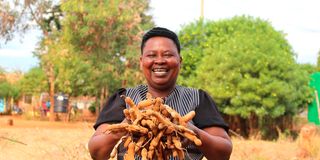How indigenous fruit trees are boosting conservation efforts

Tabitha Mueni displays a bunch of tamarind fruits in Kisayani, Makueni County on July 18 She trades in the fruits, which make food spices.
What you need to know:
- Multiple studies have shown that wild fruits and vegetables are not only healthy but also medicinal.
Outside an unassuming store at the heart of Kisayani township along the Kibwezi-Kitui Road, Tabitha Mueni weighs a sack load of tamarind, scribbles something on a notebook before she hands a wad of cash to the woman who has delivered the commodity.
The women smile to mark the end of the transaction. They are at the centre of a vibrant spices industry that puts money in the pockets of communities and traders and gives new impetus to environmental conservation.
“This consignment is destined for Mombasa. Tamarind is used to make juice and spices that go with fried potatoes, rice, meat and many other delicacies,” Ms Mueni says while showing Healthy Nation around the store where countless sacks are stacked like canned sardines. “We also buy baobab fruits from farmers and take them to Mombasa. The seeds are used to make coloured candy. Baobab candies are a big commodity in towns. Baobab pulp is used to make food supplements and smoothies, which are served in high end restaurants”.
Ms Mueni is among dozens of traders in the semi-arid region whose nature-based enterprises have boosted environmental conservation. They saw a business opportunity in baobab and tamarind fruits, commodities which a section of the community holds in high esteem, and tapped it. The Ngulya community, which dominates the region around Kisayani township, is known for spicing porridge with tamarind and baobab pulp, as well as eating baobab leaves as vegetables. Their neighbours, however, cannot touch the commodities. They associate wild fruits and vegetables with poverty. Yet multiple studies have shown that wild fruits and vegetables are not only healthy but also medicinal. Multiple government agencies and non-governmental organisations have targeted the region with concerted campaigns geared towards changing the attitude of local communities towards indigenous trees.
“Indigenous trees are nature's gift to local communities and the environment. Unlike exotic trees, indigenous trees are highly adapted to their habitats. They do not require fertiliser and pesticides to produce healthy fruits and vegetables, high quality honey, medicine, highly valuable timber and wood fuel over and above the ecosystem role to the environment. Some like the acacia tortillas are the sources of the finest forage for bees which make high quality honey. However, indigenous trees are faced with the double whammy of climate change and destruction by humans. They are highly targeted by loggers. That is why we need to be deliberate in their conservation and restoration,” said David Mutunga, a climate action expert at Dorcas Aid International, one of the development agencies running an active programme on landscape restoration in the region. The agency works with schools and beekeeping communities in Kitui County to promote the conservation and restoration of natural habitats.
Mushrooming of nature-based enterprises has sparked hope for environmental recovery in the region ravaged by wanton logging and destruction of ecosystems. One such enterprise makes assorted high-end products from baobab and tamarind at a makeshift factory on the fridges of Kisayani township. “Our portfolio includes baobab coffee, baobab pulp, baobab seed cake, tamarind spice, and tamarind seed cereal. They are inspired by multiple studies which have revealed that baobab is rich in carbohydrates, calcium, fat and protein.
“We make baobab coffee by roasting the seed in a controlled environment. It has the strong aroma of conventional coffee. It is used for making a special ready-to-drink beverage. A spoonful is added to a cup of boiling water and stirred to get a cup of the baobab coffee beverage,” said Kyalo Kalike, an accountant who is the face of the enterprise.
Although Mr Kalike ventured in the baobab and tamarind business four years ago, the innovation bug bit him when he was in secondary school. After working as an accountant at a Mombasa casino for 10 years, the youthful Mr Kalike called it quits and retreated to the countryside. He joined Ms Mueni and other entrepreneurs who trade in baobab and tamarind. Soon he went into value addition to unlock the full potential of the enterprise.
“Wastes of baobab seeds and tamarind go into making a bespoke animal feed. We use the baobab seed cake with maize cobs, which we grind and use as a feed animal feed. It adds protein and calcium to the maize cobs. We also add tamarind wastes, which work as an appetiser. The traces of tamarind pulp in the feed also adds essential minerals, making the feed wholesome,” he said.
Mr Kalike’s enterprise is hinged on dozens of farmers, mostly his neighbours, who deliver the commodities. They have become the biggest environmental stewards. “In this region, it has become unthinkable to bring down baobab and tamarind trees. They are our orange trees. We have been growing some more,” said Grace Maundu.
The Kenya Forest Research Institute (Kefri) has teamed up with the Japanese International Cooperation Agency to promote the conservation of baobabs. It promotes the consumption of baobab leaves as a healthy vegetable among pupils in Kitui County schools.
At the same time, scientists at the forestry research agency have embarked on experimenting with making potting material from the outer cover of a baobab fruit, which is currently used as fuel. It also makes briquettes. The success of the experiment is expected to boost conservation of the giant trees found mainly in a narrow belt covering Kitui and Makueni counties.
Environmentalists see President William Ruto’s drive to grow 15 billion trees by 2032 as a big opportunity to promote the uptake of indigenous trees to create sustainable livelihoods and stem the adverse effects of climate change. Kefri, for instance, has rolled out an ambitious campaign to promote the domestication of selected indigenous trees by training communities and nursery operators on how to overcome seed dormancy, one of main challenges in the growing of indigenous trees. The forestry agency also promotes the use of zai pits in growing seedlings as a strategy to enhance their survival in drylands. “The seeds of some of the indigenous trees such as melia vonkensii require delicate incision while others such as acacia tortillas need to be soaked in lukewarm water overnight to break dormancy before sowing. October is the best time to plant seedlings so that they enjoy the short rainy season and the long rainy season which follows after a brief dry spell. We are encouraging farmers and conservationists o prioritise indigenous trees in their tree growing campaigns,” Michael Okeyo, the head of Kefri's Kibwezi research station said in Thange, Makueni County during this year’s World Environment Day celebrations.





